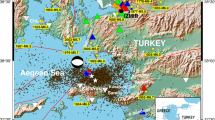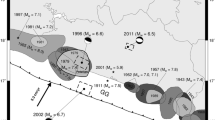Abstract
The 28 February 1969 (Ms 8.0) Cape St. Vincent earthquake is the largest shock to have occurred in the region after the Lisbon earthquake of 1755. However, the study of the rupture process has been limited due to the characteristics of the available seismic data which were analogue records that were generally saturated at both regional and teleseismic distances. Indeed, these data consist of just one accelerograph record at the 25th April Bridge in Lisbon (Portugal) and the observed intensities in the Iberian Peninsula and northern part of Morocco. We have used these data to simulate the distribution of PGV (Peak Ground Velocity) for the 1969 event at regional distances (less than 600 km) by using a 3D velocity model. The PGV values are very important in seismic hazard studies. The velocity model and the methodological approach were tested by comparing synthetic and observed ground velocities at regional distances for two recent, well-studied earthquakes that occurred in this region, namely, the 2007 (Mw = 5.9) and the 2009 (Mw = 5.5) earthquakes. By comparing the synthetic and observed PGA (Peak Ground Acceleration) at Lisbon, the focal depth was estimated equal to 25 km and the seismic moment equal to 6.4 × 1020 N m (Mw = 7.8) for 1969 earthquake. With these parameters, PGV values were obtained for 159 sites located in the Iberian Peninsula and northern region of Morocco where we have felt intensity values. Using different empirical relations, the instrumental intensity values were calculated and compared with the felt intensities. As a result, the synthetic PGV values obtained in this study for the 1969 earthquake could be used as reference values, and the methodological approach would allow the PGV and intensity to be simulated for other events in the region.











Similar content being viewed by others
References
Baptista, M. A., Miranda, J. M., Chiericci, F., & Zitellini, N. (2003). New study of the 1755 earthquake source based on multi-channel seismic survey data and tsunami modeling. Natural Hazards and Earth Systems Sciences,3, 333–340.
Baptista, M. A., Miranda, J. M., & Luís, J. F. (2006). In search of the 31 March 1761 earthquake and tsunami source. Bulletin of the Seismological Society of America,96(2), 713–721. https://doi.org/10.1785/0120050111.
Buforn, E., Udías, A., & Colombás, M. A. (1988a). Seismicity, source mechanisms and tectonics of the Azores-Gibraltar plate boundary. Tectonophysics,152, 89–118.
Buforn, E., Udías, A., & Mézcua, J. (1988b). Seismicity and focal mechanisms in south Spain. Bulletin of the Seismological Society of America,78, 2008–2224.
Cunha, T. A., Matias, L. M., Terrinha, P., Negredo, A. M., Rosas, F., Fernandes, R. M. S., et al. (2012). Neotectonics of the SW Iberia margin, Gulf of Cadiz and Alboran Sea: a reassessment including recent structural, seismic and geodetic data. Geophysical Journal International,188, 850–872. https://doi.org/10.1111/j.1365-246X.2011.05328.x.
Faenza, L., & Michelini, A. (2010). Regression analysis of MCS intensity and ground motion parameters in Italy and its application in ShakeMap. Geophysical Journal International,180, 1138–1152. https://doi.org/10.1111/j.1365-246X.2009.04467.x.
Fukao, Y. (1973). Thrust faulting at a lithospheric plate boundary: the Portugal earthquake of 1969. Earth and Planetary Science Letters,18, 205–216.
Grandin, R., Borges, J. F., Bezzeghoud, M., Caldeira, B., & Carrilho, F. (2007a). Simulations of strong ground motion in SW Iberia for the 1969 February 28 (Ms = 8.0) and the 1755 November 1 (M ~ 8.5) earthquakes–I. Velocity model. Geophysical Journal International,171, 1144–1161.
Grandin, R., Borges, J. F., Bezzeghoud, M., Caldeira, B., & Carrilho, F. (2007b). Simulations of strong ground motion in SW Iberia for the 1969 February 28 (Ms = 8.0) and the 1755 November 1 (M ~ 8.5) earthquakes–II. Strong ground motion simulations. Geophysical Journal International,171, 807–822.
Grimison, N., & Chen, W. (1988). Focal mechanisms of four recent earthquakes along the Azores-Gibraltar plate boundary. Geophysical Journal of the Royal Astronomical Society,92, 391–401.
Gutscher, M. A., Baptista, M. A., & Miranda, J. M. (2006). The Gibraltar Arc seismogenic zone. Part 2: Constraints on a shallow east dipping fault plane source for the 1755 Lisbon earthquake provided by tsunami modeling and seismic intensity. Tectonophysics,426(1–2), 153–166.
Kaka, S. I., & Atkinson, G. M. (2004). Relationships between instrumental ground-motion parameters and Modified Mercalli Intensity in Eastern North America. Bulletin of the Seismological Society of America,94, 1728–1736.
Larsen, S.C. & C.A. Schultz (1995). ELAS3D, 2D/3D elastic finite-difference wave propagation code, Lawrence Livermore National Laboratory, UCRLMA-121792, 18 pp
Levander, A. R. (1988). Fourth-order finite-difference P-SV seismograms. Geophysics,53, 1425–1436.
Lopez Arroyo, A., & Udías, A. (1972). Aftershock sequence and focal parameters of the February 28, 1969, earthquake of Azores–Gibraltar fracture zone. Bulletin of the Seismological Society of America,62, 699–720.
López-Sánchez, C., Lozano, L., Buforn, E., Martínez-Solares, J. M., Cantavella, J. V., & Udías, A. (2019). Re-evaluation of seismic intensity for the February 28, 1969 main shock and relocation of main aftershocks. In Proceeding of the Workshop “Earthquakes and tsunamis in Iberia: 50th years of the 1969 Saint Vincent earthquake (M = 8.0)”. Madrid, Spain: Universidad Complutense de Madrid.
McKenzie, D. P. (1972). Active tectonics of the Mediterranean region. Geophysical Journal of the Royal Astronomical Societ,30, 109–185.
Pro, C., Buforn, E., Bezzeghoud, M., & Udías, A. (2013). The earthquakes of 29 July 2003, 12 February 2007, and 17 December 2009 in the region of Cape Saint Vincent (SW Iberia) and their relation with the 1755 Lisbon earthquake. Tectonophysics,583, 17–27. https://doi.org/10.1016/j.tecto.2012.10.010.
Stich, D., Ancilla, F., Pondrelli, S., & Morales, J. (2007). Source analysis of the February 12th 2007, Mw 6.0 Horseshoe earthquake: Implications for the 1755 Lisbon earthquake. Geophysical Research Letters,34, L12308. https://doi.org/10.1029/2007gl030012.
Udías, A., López Arroyo, A., & Mézcua, J. (1976). Seismotectonics of the Azores–Alboran region. Tectonophysics,31(1976), 259–289.
Vilanova, S. P., Nunes, C. F., & Fonseca, J. F. B. D. (2003). Lisbon 1755: A case of triggered onshore rupture? Bulletin of the Seismological Society of America,93, 2056–2068.
Wald, D. J., Quitoriano, V., Heaton, T. H., Kanamori, H., Scrivner, C. W., & Worden, C. B. (1999). TriNet “ShakeMaps”: rapid generation of instrumental ground motion and intensity maps for earthquakes in southern California. Earthquake Spectra,15, 537–556.
Wu, Y. M., Teng, T. L., Shin, T. C., & Hsiao, N. C. (2003). Relationship between peak ground acceleration, peak ground velocity, and intensity in Taiwan. Bulletin of the Seismological Society of America,93, 386–396.
Zitellini, N. L. A., Mendes, D., Córdoba, J., Dañobeitia, R., Nicolich, G., Pellis, A., et al. (2001). Source of 1755 lisbon earthquake and tsunami investigated. EOS Transactions of the American Geophysical Union,82(26), 290–291.
Acknowledgments
This work has been partially supported by MEIC, project CGL2017-86070-R and by the European Union through the European Regional Development Fund, included in the COMPETE 2020 through ICT project (UID/GEO/04683/2019) and SFRH/BSAB/143063/2018 (reference 0061205). The authors are grateful to the Instituto Geográfico Nacional (IGN), Western Mediterranean (WM) and Instituto Português do Mar e da Atmosfera (IPMA) for providing part of the catalogue data and the waveforms used in this study. We are grateful to Professor Jiri Zahradnik and to an anonymous reviewer for their valuable comments and careful review that significantly improved this work.
Author information
Authors and Affiliations
Corresponding author
Additional information
Publisher's Note
Springer Nature remains neutral with regard to jurisdictional claims in published maps and institutional affiliations.
Rights and permissions
About this article
Cite this article
Pro, C., Buforn, E., Udías, A. et al. Study of the PGV, Strong Motion and Intensity Distribution of the February 1969 (Ms 8.0) Offshore Cape St. Vincent (Portugal) Earthquake Using Synthetic Ground Velocities. Pure Appl. Geophys. 177, 1809–1829 (2020). https://doi.org/10.1007/s00024-019-02401-2
Received:
Revised:
Accepted:
Published:
Issue Date:
DOI: https://doi.org/10.1007/s00024-019-02401-2










